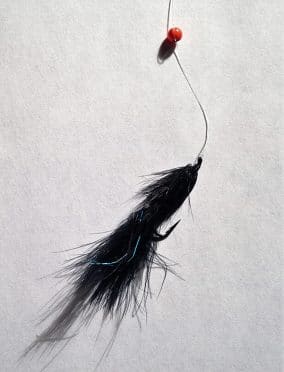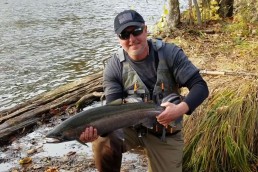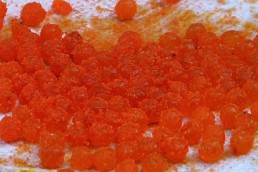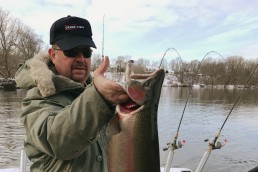Steak and Eggs for Steelhead
SHARE THIS POST
Fall on a great lakes tributary is an awaited fishing event for many anglers. Salmon gather in masses near tributary mouths, then travel upstream to spawn. Most of the large salmon runs of the season are triggered by storm fronts that bring rain. These rain events cause the tributaries to rise, and the salmon enter the tributaries in droves.
Anglers aren’t the only ones excited about the spawning salmon entering the tributaries. The resident steelhead of the great lakes also look forward to the spawning event. They will follow the spawning salmon into the tributaries. Not only do the steelhead follow the salmon, they virtually stalk the spawning salmon. Steelhead aren’t following the salmon because they’re nosey, they are following the salmon because of an insatiable hunger for the deliciously nutritious eggs that the salmon will be depositing in the tributary.
Breakfast is served!
During the salmon spawn, steelhead will set up in feeding stations a few yards behind salmon that are actively spawning. They consume huge amounts of salmon eggs. Their appetite for these protein-rich eggs seems insatiable. The steelhead just don’t eat the salmon eggs because of the taste. These steelhead need to eat large amounts of eggs to fuel their bodies, providing strength and stamina for their own spawn in the early spring.
Anglers have certainly figured out the concept of steelhead eating salmon eggs. Many anglers will be casting and drifting salmon eggs in hopes of hooking a big steelhead. For the most part, this is a very effective technique for catching steelhead in the tributaries. If the angler performs the tactic in the right location. Location is pretty darn important.
Location, location, location
Salmon and the steelhead following them may be anywhere within the tributary water. But, salmon don’t spawn everywhere. Many anglers see salmon holding in deep pools, so they drift salmon eggs through these pools in hopes of catching steelhead. In reality, salmon spawn and lay eggs in the gravel areas of riffle sections of the tributaries. For salmon, pools are resting locations between traveling intervals. Some salmon eggs may drift downward into a pool and trigger an occasional feeding, but the real event happens in the riffles.
Leave the heavy lines at home
Salmon and steelhead have a different perspective on monofilament. Salmon are so focused on migration and spawning, they ignore the fishing lines in the water. Steelhead can be very line shy. Spooling 20-pound-test monofilament, or a 15-pound-test leader usually won’t bother salmon but will be unfavorable for most steelhead.
Are you enjoying this post?
You can be among the first to get the latest info on where to go, what to use and how to use it!
For steelhead, load that reel with 4- to 8-pound-test fishing line. Fly-fishing leaders should be in the same pound test. If the water is low or super clear, the steelhead will be considerably spookier. Go with a lighter pound test in those conditions. Consider using fluorocarbon fishing line and leaders. Yep, it’s more expensive, but can make a big difference with line-shy steelhead. Along with having the advantage of nearly disappearing in the water, the toughness of the line preforms well when bumping up against numerous underwater rocks.
The jig is up, or is it?

There’s no doubt that steelhead are eating lots of salmon eggs while they are in the tributaries. After a few days tick past, they start figuring out that some of those eggs are attached to pointy hooks. Instead of gobbling up every single drifting egg they see, some start being critical of those salmon eggs.
To trigger those feeding strikes, modify the menu. Give those steelhead a combo known as “steak and eggs”. This combination not only provides a feeding response, but also triggers an instinctive chase response. When a steelhead sees another aquatic resident chasing after a drifting salmon egg, the steelhead will intercept or terminate the aquatic resident.
Easy to rig, hard to resist
The steak and egg rig is quite easy to rig. It can be utilized with spinning lures, plugs or spoons, and can also be used with a number of fishing flies. To begin, the angler will need a colored bead. These beads come in many different colors and sizes, and can be made of metal, glass or plastic. Different material will constitute different levels of weight. For color, imitate the color of the egg that is currently preforming best on the tributary. Generally, freshly deposited eggs will be more translucent and have a bright red or orange color. After eggs have been in the water for a few days, they will lighten in color. Adjust colors as needed. An egg color that works well one day may not be the best choice the next day. Best sizes of these beads are from 6 to 10 mm, with the smaller sizes being best in water that is low and clear.
Beads have a hole drilled through the center, so rigging is simple. Push the monofilament or fly-fishing leader through the hole in the bead, then loop the end over the bead and put the line back through the same hole. The bead on the line should be about 6 to 8 inches from the end of the line. This gives ample room to knot a lure or fishing fly at the end of the line. Tie the lure or fishing fly so that it is two inches from the attached bead. After tying on the lure or fly of choice, the distance to the bead can be easily adjusted by loosening the mono loop around the bead, then moving the bead to the preferred spot.
The steak and egg combo is simple and deadly for steelhead in the tributaries. Be sure to check the legal regulations on tributaries that have designated fly-fishing only sections. Steak and eggs is the breakfast of choice for steelhead!
MWO
SHARE THIS POST
Did you enjoy this post?
You can be among the first to get the latest info on where to go, what to use and how to use it!
John Murray
John Murray has a passion for the outdoors. A former professional fly tyer and fishing shop owner for more than a decade, John is a member of the NYS Outdoor Writers Association and is determined to share an acquired lifetime of knowledge to help everyone become proficient hunters and anglers.



